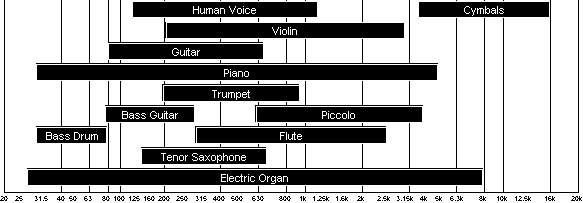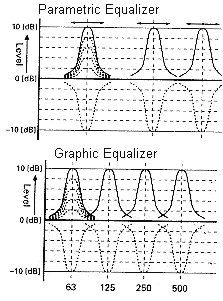Equalizers are used to fine tune a system, not to fix design flaws. If you have to use a lot of equalization, there is a problem with the system that should be solved first by relocating speakers, changing crossover frequencies, amplifier gains, etc. Equalizers are valuable instruments to flatten a system’s frequency response (making the levels the same at all frequencies). In competition, a measurement is taken on how flat the response of a system is. More points are given to a competitor with a flatter response. In a real system, a flat frequency response is a starting point, but does not ultimately mean perfect sound since human ears are not sensitive at the same level to all frequencies.
Many people believe that an equalizer is to boost power by raising signal levels. 95% of the time an equalizer should be used to cut levels rather than boost them. In a well designed system the settings on an equalizer should not be too far from the zero dB line.
Frequency
Frequency is how many times per second a signal (AC) switches from positive to negative and back, measured in Hertz (see page on “Electrical Concepts” for a more extensive explanation). The frequency range in which we are interested for audio is from 20 Hertz to 20,000 (20k) Hz. The lower the frequency, the slower the signal oscillates.

The frequency spectrum is read using a logarithmic scale, and is divided in octaves (doubling of the frequency). Octaves are for example, 20, 40, 80, 160, 315, 630 Hz and so on. Equalizers are divided in octaves, 1/2 octaves or 1/3 octaves. A 1 octave equalizer can only control 7-9 bands (frequencies), while a 1/2 octave equalizer can control 15 bands. A 1/3 octave equalizer would give you the most control over the system, by being able to adjust 30 -31 bands.
Q
Q is a measurement of how much the equalizer band affects a range of frequencies. A high Q means that the EQ can control a lower “envelope” of frequencies, while a low Q is a larger envelope. Looking at the image on the right, Q is the thickness of the affected frequencies. A smaller Q means a wider range of frequencies boosted or cut, while a larger Q is a narrower shape. Typical Q values are 1, 2 and 3.

Parametric vs. Graphic Equalizers
A graphic equalizer has usually fixed frequency and Q value. The layout of a graphic equalizer is the typical sliding controls arranged by frequency. The advantage of a graphic equalizer is that in the way it is laid out, it is easy to see what frequency is being boosted or cut and any person without much experience can adjust it. Since a graphic EQ has fixed frequencies and Q, it has limitations on what it can control.
A parametric equalizer consists of knobs that are turned to desired levels, have adjustable frequencies and (usually) Q. The advantage of parametric equalizers is a much greater control, since frequencies and Q values can be adjusted. On the other hand, a parametric equalizer is much harder to adjust than a graphic EQ, requiring an experienced person and measuring equipment.
Mono and Stereo Equalizers
The main difference between mono and stereo EQs is that a mono EQ has only one input and one output, and a stereo has two inputs and two outputs. They both have their advantages and disadvantages: A stereo EQ controls your whole system (both left and right channels) and it is easy to adjust: Just turn the knob or slider and both left and right channels are taken care of. If you want to adjust left and right channels independently, you can’t!
A mono EQ controls only one channel, so you need two of them for the whole system. Since you have now two EQs it takes a lot more time to setup the system. Many people use mono EQs for the greater control they give over the system. Since left and right speakers are not exactly at the same distance to our ears, two mono EQs can help compensate for time delays and problems caused by speaker placement. Buying two mono equalizers is more expensive than buying one stereo EQ.
Low Level and High Level Output
A high level output equalizer takes either high level (speaker) or low level (RCA) inputs and has a built in amplifier. The output goes directly to the speakers and can not be hooked up to another amplifier. These equalizers are cheap and cause more damage than good to the sound system. They do “boost” signals, but all this does is add distortion to the overall sound.
A low level input EQ takes RCA signals from the radio and has RCA outputs that get hooked up to amplifiers. Since these equalizers work at low signal levels, they introduce very little distortion, if any to the system. They do cost more and require more wiring than a high level EQ.
A third kind of equalizer gets hooked up directly to the head unit via a special cable and is controlled by the head unit. These EQs use low level signals and are usually of good quality. The drawback is that if you want to upgrade the head unit or change brands, the EQ will not be compatible with other brands or even with different models from the same manufacturer.